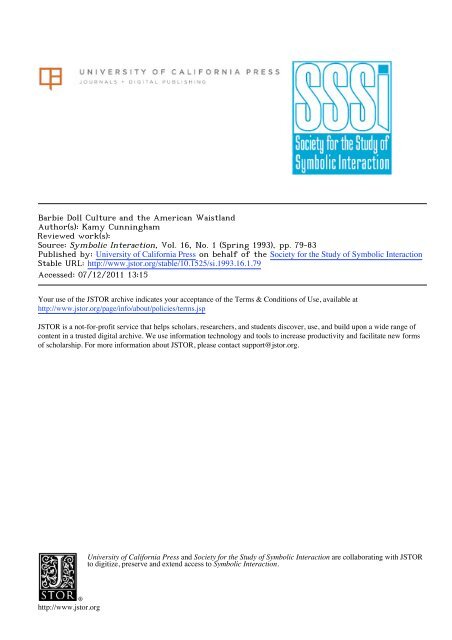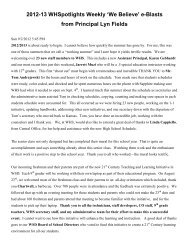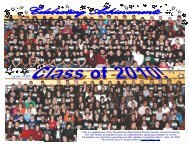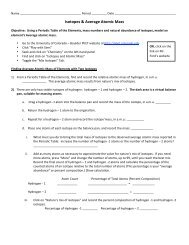Barbie Doll Culture and the American Wasteland
Barbie Doll Culture and the American Wasteland
Barbie Doll Culture and the American Wasteland
You also want an ePaper? Increase the reach of your titles
YUMPU automatically turns print PDFs into web optimized ePapers that Google loves.
!"#$%&'()**'+,*-,#&'"./'-0&'12&#%3".'4"%5-*"./<br />
1,-0)#6578'9"2:'+,..%.;0"2<br />
&/'>)#?6578<br />
@),#3&8'@:2$)*%3'A.-&#"3-%).B'C)*D'EFB'G)D'E'6@H#%.;'EIIJ7B'HHD'KILMJ<br />
N,$*%50&/'$:8'University of California Press').'$&0"*O')O'-0&'Society for <strong>the</strong> Study of Symbolic Interaction<br />
@-"$*&'P
<strong>Barbie</strong> <strong>Doll</strong> <strong>Culture</strong> <strong>and</strong> <strong>the</strong><br />
<strong>American</strong> Waistl<strong>and</strong><br />
<strong>Barbie</strong>, <strong>the</strong> doll, is also known as Vanna White, Marilyn,<br />
Marlene, Cleopatra, <strong>and</strong> for some, she is one of those<br />
nameless, lanky dancing showgirl Rockettes who perform<br />
at Caesars Palace. An anti-clone for every woman<br />
who wishes to be more than surface deep, she is alterego<br />
ideal for <strong>American</strong> Man. Virginlwhore, she makes<br />
men out of little boys. But like Rain Man lost in Las<br />
Vegas, some day she will hunger, we hope, for a minded<br />
self that embodies more than physical beauty <strong>and</strong><br />
wealth.<br />
Kamy Cunningham underst<strong>and</strong>s all of this. As a woman<br />
trapped in a <strong>Barbie</strong>-based, barbaric culture, where <strong>the</strong><br />
cult of Eros <strong>and</strong> Beauty reign, she seeks to be o<strong>the</strong>rwise.<br />
Her essay provides a reflection on contemporary America,<br />
a waistl<strong>and</strong> Eliot never imagined. An example of what<br />
Andrea Fontana (after Lyotard) calls <strong>the</strong> petit recit, her<br />
“impressionist-personal” <strong>and</strong> oppositional reading of<br />
this slice of <strong>American</strong>a brings us inside <strong>the</strong> “feminine<br />
sociological imagination.” Praxis <strong>and</strong> critical <strong>the</strong>ory<br />
come toge<strong>the</strong>r in her paragraphs, as she challenges<br />
readers to inspect <strong>the</strong>ir own gendered identities, <strong>and</strong> to<br />
ask that painful question: “Have 1 been made in <strong>Barbie</strong>’s<br />
mold?” This is what good interactionist sociology is all<br />
about.<br />
-Norman K. Denzin<br />
University of Illinois at Urbana-Champaign<br />
KamY Cunningham‘<br />
University Of Nevada,<br />
Las Vegas<br />
A Waistl<strong>and</strong> is a l<strong>and</strong> where, if you’re a woman, you have to have a tiny waist in<br />
order to not feel like something <strong>the</strong> cat drug out of <strong>the</strong> garbage bin. I remember<br />
at age ten gazing at my first <strong>Barbie</strong>, <strong>the</strong> sloe-eyed version with painted<br />
toenails in its zebra-striped suit, <strong>and</strong> deciding, well. I guess this pneumatic<br />
creature (I already had a pretty sophisticated vocabulary back <strong>the</strong>n) with <strong>the</strong><br />
~ ~~ ~~ ~~ ~~<br />
Direct all correspondence to: Dr. Kamy Cunningham. University of Nevada, Las Vegas, Department of<br />
English. 4505 Maryl<strong>and</strong> Pkwy., Las Vegas, NV 89 154.<br />
Symbollc Intcractlon, l6( 1):79-83<br />
ISSN 0195-6086<br />
Copyright 0 1993 by JAI Press, Inc.<br />
All rights OF reproduction in any form reserved.
80 Symbolic Interaction Volume 16 I Number 1 / 1993<br />
long, horsey legs <strong>and</strong> Scarlett O'Hara waist was what I was supposed to grow<br />
up to look like.<br />
Doesn't every little, <strong>and</strong> big, <strong>American</strong> girl want to look like <strong>Barbie</strong>? And<br />
doesn't she want to be <strong>Barbie</strong>, wholesome <strong>and</strong> popular <strong>and</strong> perky? In short, a<br />
plastic doll.<br />
<strong>Barbie</strong> beckons us little, <strong>and</strong> big, girls, but toward what? And if it's toward<br />
beauty, what sort of beauty is this, with its tiny waist?<br />
During a moment of epiphany in <strong>the</strong> middle of a television commercial <strong>the</strong><br />
o<strong>the</strong>r night (most people just go to <strong>the</strong> bathroom), I speculated that it might<br />
be <strong>the</strong> beauty of <strong>the</strong> Heartl<strong>and</strong> of America, cholesterol free <strong>and</strong> patriotically<br />
waving tubs of margarine called Promise.<br />
The show between <strong>the</strong> commercials was <strong>the</strong> Ms. Teenage America Pageant<br />
followed, a couple of days later, by a grown-up beauty contest, <strong>the</strong> Supermodel<br />
of <strong>the</strong> Year. The teenage hopefuls were all ruffles <strong>and</strong> tans <strong>and</strong> souffles<br />
of cliches, each determined to be herself <strong>and</strong> not succumb to peer pressure<br />
<strong>and</strong> to work with <strong>the</strong> h<strong>and</strong>icapped, <strong>the</strong> learning disabled, <strong>the</strong> old, <strong>and</strong> <strong>the</strong><br />
terminally ill because, of course, <strong>the</strong> most wonderful thing in life is to help<br />
o<strong>the</strong>rs <strong>and</strong> be <strong>the</strong> best you can be.<br />
Their supermodel counterparts were slinky, <strong>and</strong> slid along <strong>the</strong> stage like<br />
skinny eels, in that funny model posture, pelvis jutting forward, small bosoms<br />
receding onto <strong>the</strong> terrace of <strong>the</strong> breastbone, that makes a woman look like a<br />
limp piece of spaghetti about to fall over-backwards.<br />
<strong>Barbie</strong> combines <strong>the</strong> prototypes of <strong>the</strong> two pageants-she's all ruffles <strong>and</strong><br />
cuteness <strong>and</strong> all experienced slinkiness. A recent version, <strong>the</strong> Fashion Play<br />
<strong>Barbie</strong>, is a good illustration of what I mean. Clad in a Frederick's of Hollywood<br />
wisp of lingerie <strong>and</strong> topped by luxuriant platinum tresses, <strong>the</strong> doll has lavender<br />
eyes, both willing <strong>and</strong> innocent, that look out of a face cutely dimpled <strong>and</strong><br />
empty of feminine guile, yet somehow eerily seductive.<br />
In her own plastic person, <strong>Barbie</strong> carries <strong>the</strong> VirginANhore paradox to an<br />
even more tensile extreme than does, say, a Marilyn Monroe, or a Madonna.<br />
Marilyn combined helpless, yielding child with voluptuous, knowing woman in<br />
a caricature of <strong>the</strong> two that was almost obscene. Madonna-shrewd, ruthless,<br />
experienced, slightly perverse-is a walking, strutting contradiction to <strong>the</strong><br />
name of <strong>the</strong> Virgin she has appropriated.<br />
Slip off that wisp of lingerie, barely clinging to those fulsome curves, <strong>and</strong> a<br />
naked <strong>Barbie</strong> doll is a sexy thing. Pouty bosom, that tiny waist so oft spoke of,<br />
flared hips, lissome legs. Squeeze her <strong>and</strong> knead her <strong>and</strong> she has a rubbery life<br />
of her own. Cup her, King Kong fashion, <strong>and</strong> feel <strong>the</strong> points of <strong>the</strong> breasts<br />
press into your palm. Run your h<strong>and</strong> down <strong>the</strong> full 1 1 - 112" <strong>and</strong> experience<br />
cool, clean silk feel of plastic. Wholesome <strong>and</strong> seductive.<br />
Is this beauty? Egyptian woman painted <strong>the</strong>ir eyelids a heavy charcoal black.<br />
Medieval paintings show that women with small tulip breasts <strong>and</strong> big, ovenrounded<br />
bellies were desirable. Rubens <strong>and</strong> Titian <strong>and</strong> lngres thought that
<strong>Barbie</strong> <strong>Doll</strong> 81<br />
women layered like lily-white, hothouse marshmallows were best. In some<br />
cultures <strong>the</strong> male is <strong>the</strong> heavily painted <strong>and</strong> artificial one. Like an obscene,<br />
opalescent peacock or an aquamarine bird of paradise with blue dragons<br />
curling around his arms, in sinuous indigo, he gyrates in front of <strong>the</strong> womenfolk,<br />
hoping (<strong>and</strong> hopping) to be “pretty” enough to be picked.<br />
The question is not really one of beauty, of course, but of <strong>the</strong> oppressive<br />
equation of beauty, however we define it, with worth. Surface so dominates<br />
essence in America that <strong>the</strong> equation has gotten out of h<strong>and</strong>. The reason is<br />
obvious. We are bombarded by images of <strong>Barbie</strong> doll women. On a recent<br />
Smithsonian World, a popular culture critic called advertising “one of <strong>the</strong><br />
predominate art forms of our time.” Advertising is so dominate, <strong>the</strong> show<br />
goes on to say, that “its messages are <strong>the</strong> only ones being heard.” “America is<br />
about selling” <strong>and</strong> “we accept <strong>the</strong> marketplace as <strong>the</strong> arbiter of values.”<br />
Ads create <strong>the</strong> symbols of our culture; <strong>the</strong>y suggest that <strong>the</strong> Johnson’s<br />
make-me-your-baby-powder woman is <strong>the</strong> only acceptable version of <strong>the</strong><br />
feminine.<br />
When I was ten years old, I didn’t know that I was longing for a Rubenesque<br />
or a Titianesque, ra<strong>the</strong>r than a <strong>Barbie</strong>sque, visual model. I didn’t know at <strong>the</strong><br />
time that she was influencing <strong>and</strong> reinforcing impossible cultural norms of<br />
physical beauty, norms that I would never be able to even approximate. I<br />
didn’t know that most men want <strong>Barbie</strong> doll women, <strong>the</strong> ones with long<br />
blonde hair, innocent baby-blue (or baby-lavender) eyes, substantial Cosmocover<br />
melons, tiny waists, flat tummies, taut bottoms, <strong>and</strong> long graceful legs.<br />
(And absurdly small feet: <strong>Barbie</strong> doesn’t even have to wear heels in order to<br />
be “hobbled”-it’s built into those ridiculous concubine feet.) I didn’t know<br />
that to be considered desirable, I would have to be a centerfold, zipped into<br />
my nakedness like a shrimp in its casing.<br />
If I had known all of this, I would probably have thrown myself off Hoover<br />
Dam <strong>and</strong> never reached age eleven.<br />
There are some o<strong>the</strong>r things wrong with <strong>Barbie</strong> too. She’s a simulacrum of a<br />
human being, a sad grotesquerie: her creators gave her breasts but no nipples,<br />
flared hips but no womb, seductively spread legs but no vagina. No milk,<br />
no sucklings, no procreation. A twilight zone creature, as strange as her lifesired<br />
counterpart-<strong>the</strong> department store mannequin with <strong>the</strong> sterility of a<br />
lavender sheen on its cadaverous, blue-grey cheeks-she is an emblem of<br />
frustration <strong>and</strong> unfulfillment.<br />
In Las Vegas, at Caesars Palace, an enormous figurehead of Cleopatra juts<br />
out over <strong>the</strong> casino. With her huge bronze breasts that dangle above your<br />
head <strong>and</strong> her ample but shapely girth, she looks as if she could have mo<strong>the</strong>red<br />
<strong>the</strong> whole human race. Instead, taut in every disappointed muscle, she<br />
strains out into nothing, gazing at this sterile indoor cosmos of star-spangled<br />
ch<strong>and</strong>eliers.<br />
Las Vegas showgirls look manufactured-identical lanky clones carrying ten
~~~~ ~<br />
82 Symbollc Interaction Volume 16 / Number 1 / 1993<br />
pounds of fea<strong>the</strong>rs above eyes so mascared no eyes are <strong>the</strong>re. Ads across <strong>the</strong><br />
country misrepresent <strong>the</strong>m as voluptuous; actually, by some ironic twist,<br />
<strong>the</strong>y’re all tiny-bosomed because big breasts bounce around on <strong>the</strong> stage<br />
with <strong>the</strong> least step or jiggle. All <strong>the</strong> girls would look like cumbersome, milkheavy<br />
cows. Go to a Las Vegas show <strong>and</strong> <strong>the</strong> sensation is eerie: two-hundred<br />
identical breasts with tiny peppermint nipples point your way, like <strong>the</strong> pink<br />
noses of puppies. Beneath <strong>the</strong> nipples, identical Rockettes’ legs. Large breasts<br />
might be an improvement: <strong>the</strong> hilarity would relieve <strong>the</strong> manufactured look of<br />
<strong>the</strong> women.<br />
The “simply irresistible” clone women, of Pepsi commercial <strong>and</strong> MTV fame,<br />
produce a similar shuddering sensation. Painted over with that lavender sheen<br />
of <strong>the</strong> mannequin, with big, hard, dark eyes, <strong>and</strong> starved cheeks, <strong>the</strong>ir faces<br />
look like those of boxed dolls-identical <strong>and</strong> inexpressive. Only <strong>the</strong>ir bodies<br />
are alive, in a mechanical way, as <strong>the</strong>y move. Their eyes are dead. Some even<br />
wear goggles, blinders that make <strong>the</strong>m look like horses in harness. They have<br />
been zapped of all <strong>the</strong>ir vitality, by being turned into mindless doll-like clones.<br />
Dead dolls, vampire women. Plastic. Manufactured. Artificial. Unreal. No room<br />
for <strong>the</strong> appealing flaws <strong>and</strong> living warmth of “real” women, those whose<br />
Rubenesque curves might spread a little <strong>and</strong> whose Titianesque arms might<br />
have a bit of <strong>the</strong> soft sway of <strong>the</strong> basset hound. Warm arms, mo<strong>the</strong>rly arms.<br />
<strong>Barbie</strong>, with all of her accessories (thous<strong>and</strong>s of little outfits, <strong>and</strong> dozens of<br />
pieces of pink plastic furniture, <strong>and</strong> Hollywood hot tubs <strong>and</strong> sleek racing cars)<br />
brings in three quarters of a billion dollars a year for Mattel. Every two seconds<br />
someone somewhere in <strong>the</strong> world buys a <strong>Barbie</strong>. Numerically, <strong>the</strong>re are 2.5<br />
<strong>Barbie</strong>s for every household in America.<br />
She is obviously a powerful cultural icon, but what is her iconography? What<br />
text is she illustrating? The text of woman as manufactured cadaver? Woman<br />
robbed of any insides because she has to be all outside?<br />
<strong>Barbie</strong>’s living clone, Vanna White, Goddess of <strong>the</strong> Empty Woman, seems to<br />
be illustrating a depressing blankness (note <strong>the</strong> name White). Vanna’s message<br />
is that if you look like her <strong>and</strong> dress beautifully <strong>and</strong> smile warmly <strong>and</strong> turn<br />
letters with great skill <strong>and</strong> remain forever, mentally <strong>and</strong> emotionally, on <strong>the</strong><br />
level of an untroubled child, <strong>the</strong>n you will be valued <strong>and</strong> given lots of money.<br />
Turning letters counts for Far more, apparently, than turning a phrase. Rarely, in<br />
<strong>the</strong> history of womankind mankind, has so little been so richly rewarded.<br />
One night, on Wheel of Fortunate, she gushed, in a see-Spot-run vocabulary,<br />
over an “isl<strong>and</strong> paradise” vacation she’d just taken that was ‘‘simply wonderful”<br />
<strong>and</strong> ”so great.” (Her narrative, childishly adjectival <strong>and</strong> without a story<br />
line, had not quite reached <strong>the</strong> level of sophistication of <strong>the</strong> “cow jumped<br />
over <strong>the</strong> moon.”) I feel resentful that Vanna <strong>and</strong> her ilk (all those manufactured<br />
mannequins <strong>and</strong> cadaverous clones) can pile up fortunes by selling <strong>the</strong>ir<br />
bodies <strong>and</strong> that I can’t make anything by selling my mind.
<strong>Barbie</strong> <strong>Doll</strong> 83<br />
But, to temper my tirade (a bit), I feel a little sorry for her (<strong>and</strong> <strong>the</strong>m). And<br />
happy for me, a little. In a world where you have to sell something to survive,<br />
maybe it’s better to have a mind to market than a transient body.<br />
Perhaps, decades from now, I may be able to entertain myself with books<br />
<strong>and</strong> thoughts after all <strong>the</strong> centerfolds have sagged <strong>and</strong> <strong>the</strong> Vannas have died<br />
away from <strong>the</strong>ir own untroubled boredom.

















